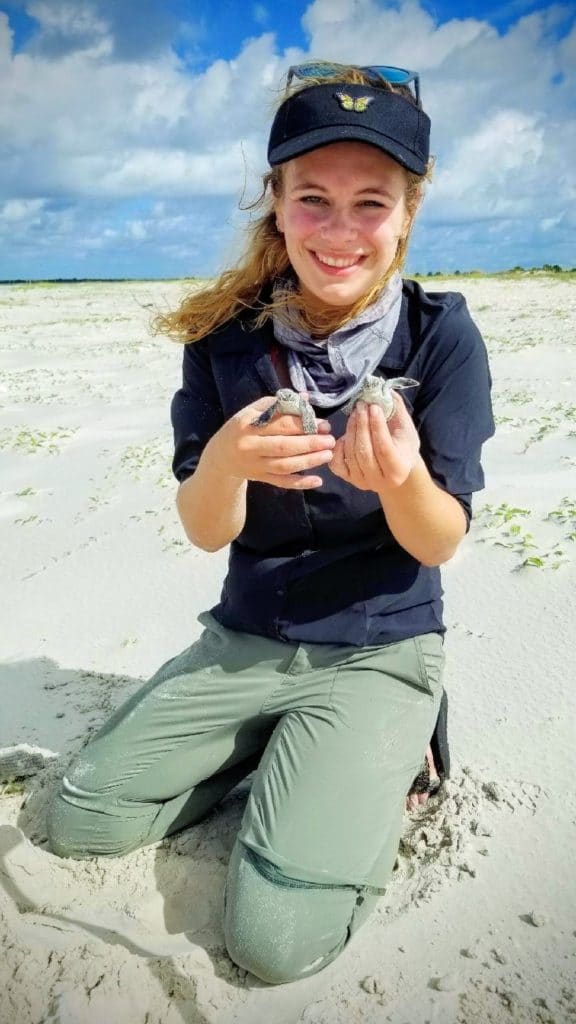Spotlight on Interns | Madeleine Soss
By Megan Lamb and Madeleine Soss
Over the past several years, the Apalachicola National Estuarine Research Reserve (ANERR) has expanded its internship programs. Internships are commonplace in STEM (Science, Technology, Engineering, and Math) fields and provide hands-on learning opportunities to students and individuals interested in natural resource fields. Early research experience can help students sharpen focus and determine which area of science suits their interests. Reserve staff act as mentors to these students, providing coaching, support, and feedback to help guide future scientists and resource stewards. ANERR works with our Friends of the Reserve group which provides invaluable financial support and dormitory housing for interns. We sat down with Madeleine Soss, a stewardship intern helping with sea turtle monitoring and other activities on Little St. George Island, to talk about her experiences this summer.
Sea turtles are a protected species. All of Madeleine’s activities were carried out under FWC Marine Turtle Permit #250 and in accordance with FWC guidelines.
Education Background:
Wake Forest University, Graduated May 2020
Major: Biology
Minor: Environmental Science
Hometown: Hendersonville, NC

ML: What got you interested in the science and natural resource fields?
MS: Coming from a rural community, much of my childhood was spent outdoors hiking, kayaking, and camping (mostly because of a lack of other things to do in the area). Close access to both state and national forests gave me a real appreciation for the integrity and importance of managed lands. Unfortunately, growing up in the Appalachian Mountains also exposed me firsthand to issues such as mountaintop removal, water pollution, and toxic waste storage. Learning that access to a clean and safe environment is not a right but rather a privilege, I gained a real passion for work in natural fields and hope to help other communities that struggle with environmental justice issues in the future.
ML: Have you had any other internships or natural resource jobs prior to this summer? If so, can you describe the position, what your job title and responsibilities were?
MS: Prior to this internship, I had mostly experience in environmental and biological education. One summer, I was a camp counselor and the environmental education coordinator at a summer camp. On top of planning daily lessons and activities, I had to manage a small nature center that included taking care of a guinea pig, snapping turtles, a tarantula, a cockatiel, and two red-tailed boas. I also led expeditions of large groups of children into the wilderness on multi-day backpacking trips. As you can imagine, it was a very interesting summer. Last summer, I was a TA for a professor at an educational summer program through Duke University. I helped teach and facilitate classroom, lab, and field experiences for an Aquatic Biology course.
ML: What are your career aspirations?
MS: I hope to work as a conservation and environmental scientist in either a park system or a governmental or research organization, but I am open to almost anything!
ML: What was the most exciting part of your internship so far?
The most exciting part of this internship is getting to interact with sea turtle hatchlings, for sure. Besides being absolutely adorable, the experience of working with such threatened and charismatic creatures has been very rewarding.
ML: What was the most surprising thing you have learned or experienced during your internship?
MS: I was surprised by the large amount of collaboration between the education, research, and stewardship branches of ANERR. Although each team has distinct responsibilities, people from all positions and perspectives are willing to help for the greater goals of the organization.
ML: What is the most valuable thing you have learned during your internship?
MS: Although I wanted to work outdoors, I was unsure about which specific ecosystem interested me most. This internship has definitely given me a great overview of what coastal/marine science looks like.
ML: How has your time with ANERR has helped you grow as a young scientist/naturalist/conservationist?
MS: Upon entering college, I was certain that I would have some sort of direction in my career by the time I graduated. However, upon receiving my degree I felt even more lost. My internship at ANERR has given me an invaluable opportunity to explore my likes and dislikes, while still allowing me to have new experiences and grow. As I currently apply for jobs, I feel confident in my new skills and fieldwork experience.
ML: Has your time at ANERR changed your expectations of a career in natural resources?
MS: My internship here really opened my eyes to the diversity of positions in this field. There many types of positions, both indoors and outdoors, that are integral to the conservation and protection of natural resources.
ML: What are your plans after your internship ends?
MS: I am currently looking for more jobs in conservation, ecology, and biology. Eventually, I hope to earn a graduate degree in wildlife/conservation biology.
ML: Is there anything else you’d like to add about your experience this summer that made an impression on you?
MS: Before my time at ANERR, I had never been on a boat, used a weed eater, or driven a UTV. All the staff here were nothing but patient and kind with my mistakes while I was traversing such as steep learning curve.
